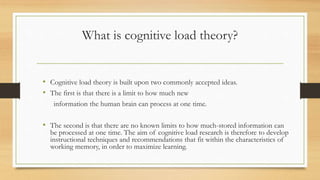cognitive load slide.pptx
- 1. COGNITIVE LOAD THEORY PRESENTED BY: KOKETSO MOSEKI
- 2. What is cognitive load theory? âĒ Cognitive load theory is built upon two commonly accepted ideas. âĒ The first is that there is a limit to how much new information the human brain can process at one time. âĒ The second is that there are no known limits to how much-stored information can be processed at one time. The aim of cognitive load research is therefore to develop instructional techniques and recommendations that fit within the characteristics of working memory, in order to maximize learning.
- 3. âĒ Cognitive load theory supports explicit models of instruction, because such models tend to accord with how human brains learn most effectively (Kirschner, Sweller & Clark 2006). âĒ Explicit instruction involves teachers clearly showing students what to do and how to do it, rather than having students discover or construct information for themselves.
- 4. How the human brain learns? âĒ Working memory is the memory system where small amounts of information are stored for a very short duration (Peterson & Peterson 1959)1. Working memory roughly equates with what we are conscious of at any one time. âĒ Long-term memory is the memory system where large amounts of information are stored semi-permanently.
- 5. How the human brain learn: continuation âĒ Cognitive load theory assumes that knowledge is stored in long-term memory in the form of âschemas'2 âĒ A schema organizes elements of information according to how they will be used. âĒ According to schema theory, skilled performance is developed through building ever greater numbers of increasingly complex schemas by combining elements of lower level schemas into higher level schemas.
- 6. How the human brain learns: continuation. âĒ Children begin to learn to read by constructing schemas for squiggles on a page â letters. . Children begin to learn to read by constructing schemas for squiggles on a page â letters. âĒ These simple schemas for letters are used to construct higher order schemas when they are combined into words. The schemas for words, in turn, are combined into higher order schemas for phrases and sentences. âĒ This process of ever more complex schema construction eventually allows readers to scan a page filled with squiggles and deduce meaning from it
- 7. How the human brain learns: continuation âĒ Schemas provide a number of important functions that are relevant to learning: âĒ First, they provide a system for organizing and storing knowledge. âĒ Second, and crucially for cognitive load theory, they reduce working memory load. âĒ This is because, although there are a limited number of elements that can be held in working memory at one time, a schema constitutes only a single element in working memory. In this way, a high-level schema â with potentially infinite informational complexity â can effectively bypass the limits of working memory
- 8. âĒ If working memory is overloaded, there is a greater risk that the content being taught will not be understood by the learner, will be misinterpreted or confused, will not be effectively encoded in long-term memory, and that learning will be slowed down (Martin 2016, p. 8). âĒ The automation of schemas reduces the burden on working memory because when information can be accessed automatically, the working memory is freed up to process new information.
- 9. âĒTHE END âĒ Email address:kmoseki36@gmail.com
- 10. Reference âĒ NSW Department of Education. 2017. Centre for Education Statistics and Evaluation. Cognitive load theory: Research that teachers really need to understand.










